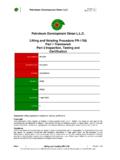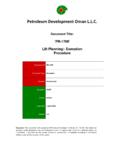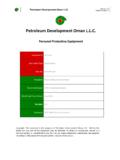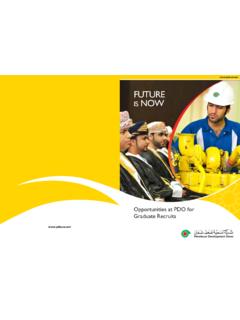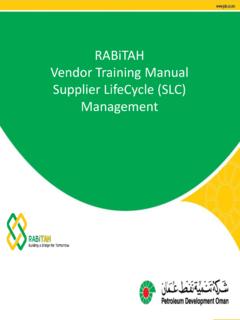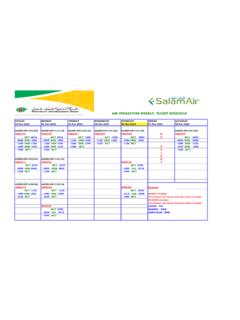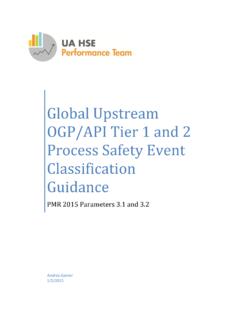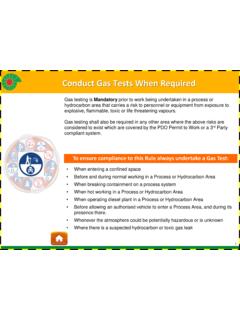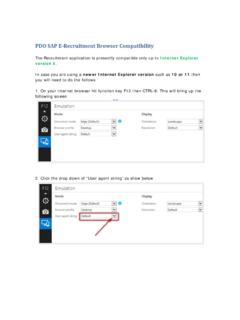Transcription of Petroleum Development Oman L.L.C. - PDO
1 Petroleum Development oman HRA Info Guide for contractors Document ID GU-725 Document Type Guideline Security Unrestricted Discipline Occupational Health Document Owner Dr. Salim Al-Sawai (MCOH) Month and Year of Issue June 14, 2014 Version Keywords Occupational Health, Industrial Hygiene, Health hazards, Copyright: This document is the property of Petroleum Development oman , LLC. Neither the whole nor any part of this document may be disclosed to others or reproduced, stored in a retrieval system, or transmitted in any form by any means (electronic, mechanical, reprographic recording or otherwise) without prior written consent of the owner. PDO HRA Info Guide March 2014 2/8 Revision History The following is a brief summary of the four most recent revisions to this document. Details of all revisions prior to these are held on file by the Document Custodian. User Notes: 1. A controlled copy of the current version of this document is on PDO's live link.
2 Before making reference to this document, it is the user's responsibility to ensure that any hard copy, or electronic copy, is current. For assistance, contact the Document Custodian. 2. Users are encouraged to participate in the ongoing improvement of this document by providing constructive feedback. Related Business Processes & CMF Documents Related Business Processes Code Business Process (EPBM ) Version No. Month & Year Author s Name and Title Scope / Remarks 14 june 2014 Jose Ref. Ind: MCOH1 HRA INFO GUIDE FOR CONTRACTORS Linked with SP-1231 PDO HRA Info Guide March 2014 3/8 Introduction This guide describes all steps for documenting the PDOs HRA for contractors. Users of this document are expected to call Occupational Health for support to perform this HRA and completed. The purpose of this document is to provide guidelines and reference material to perform the HRA in a consistent and efficient way. Legend Hints + Tips Warning Definitions Rules & Conventions PDO HRA Info Guide March 2014 4/8 Rule A: Have an HRA plan: Plan to use the available Model and a verification process for each Work Area.
3 Site wide hazards are those with principally similar exposures, controls and recovery measures across the site. Site Generic Controls, Recovery Measures and Remedial Actions are applied to more than one hazard and are principally similar across the site. Rule B: Generic hazard appraisals indicates that the assessment is typical for all jobs at that level and below. Exceptional exposure situations will then be documented at the job or task level where they occur. Rule C: All workers must be represented by a job or job category documented in a HRA. Rule D: Assign hazards to a specific job or task only when there is a significantly higher exposure. Otherwise, the hazard should be typically assigned to the Work Area Site or Unit and assessed as a generic exposure. Rule E: Job and tasks with similar exposures must be grouped . A job or task should be separated from more general categories only when there is a distinguishing exposure level.
4 The job or task should not have a hazard in the title. Rule F: Hazard Appraisal Big Rules (origin source: PDO Health hazard Inventory - HHI) Hazards RAM Ratings in HHI are provided as a minimum global standard, based on agreed Statistical Conventions. Hazards are grouped where feasible, where the nature of the material, typical uses, exposures, and effects are similar. Each Hazard in PDO HHI has to included Name, Summary of Acute and Chronic Effects, RAM ratings, and Sources of Exposure PDO HRA Info Guide March 2014 5/8 Sometimes includes a CAS number, Hazard Inventory Number, OEL s, and Monitoring Methods If a new hazard or another change is needed in the PDO HHI, contact MCOH1. Complete the Form, Route, Frequency and Duration Fields: Form of exposure means the primary form for the most typical exposure scenario. Duration means the most typical duration of the exposure, and frequency means how often the most typical exposure scenario occurs.
5 Rule G: Chemical and Biological Hazards: Complete the Form, Route, Frequency and Duration. Up to three routes of exposure can be documented: inhalation. Dermal/contact, ingestion, splash. Physical and Ergonomic Hazards: Complete the Frequency and Duration. Form and Route are left blank. Psychological hazard: Leave blank. Rule H: The Scenario is a required field and must contain a concise description of the activity or situation in which the exposure occurs (or may occur), and the job or job category exposed. Example Scenario: General workers could be exposed to dust from building material construction or environment. Rule I: Representative data from site should be used for obtaining exposure ratings. The final exposure rating can also be based on other evidence like published data and exposure monitoring results for comparable activities from other sites. Rule J: ALARP documentation must be completed when: Either, the hazard is rated M or H, OR: The hazard is rated L but has been selected for detailed appraisal based on the judgment of Occupational Health Department, AND; The answer to all the ALARP challenge questions are NO, AND; There are no remedial actions pending.
6 Among the comments and ALARP Justification fields, at least two fields must be completed documenting the consideration given to feasibility of additional controls. PDO HRA Info Guide March 2014 6/8 Rule K: Remedial actions must be SMART goals (Specific, Measurable, Action oriented, Realistic and Time limited). Begin each remedial action with an action word, and make them simple and direct. Specify the remedial actions in Section 3. Rule L: Site/Unit Generic Controls and Recovery Measures must be documented in Section 5 Site Generic Controls, Recovery Measures and Remedial Actions are applied to more than one hazard and are principally similar across the site. 1. Select the most appropriate category for the site generic controls and recovery measures according to this: Not Effective Effective Best Practice Note: Best Practice represents the best available balance of efficiency and effectiveness.
7 Best practice designations are reviewed during the Review process. The responsible for HRA will review Best Practice controls and recovery measures periodically. Rule M: The HRA must identify the MS/FtW Protocols that meet the entrance criteria, and document those assigned at Site, Assessment Unit, Job or Task Level. Jobs that have MS/FtW Protocols assigned must be documented in the HRA. These MS/FtW Protocols and Entrance Criteria Apply: Fitness to Work Protocols- Based on Tasks/Activities A1 Aircraft refuelling A2 Breathing apparatus work A4 Catering and food preparation A5 Crane driving A6 Emergency response team work A7 Professional driving Medical Surveillance Protocols- Based on Exposures MS2 Benzene MS3 Blood-borne pathogens MS4 Butadiene MS6 Chromium (hexavalent), water soluble fume MS7 Dermal irritants and dermal sensitizers MS8 Ethylene Oxide (EO)/Propylene Oxide (PO) MS9 Lead, elemental or inorganic MS10 Lead alkyls MS11 Mercury, elemental or inorganic MS 12 Nickel MS 13 Noise MS 14 Polycyclic Aromatic Hydrocarbons (PAH) MS 15 Toluene di-isocyanate PDO HRA Info Guide March 2014 7/8 For the Purpose of Assigning MS/FtW Protocols: Exposure assessments performed for the work area (Site, Unit etc.)
8 , will apply to all the jobs assigned to that work area and below. Exposure assessments performed at the job level apply to that job. Exposure assessments performed at a task level apply to the job to which the task is assigned. Rule N: Low rated hazards are confirmed as controlled by standard procedures and staff competencies the generic and other documented controls and recovery measures, unless there is a reason to believe a harmful exposure is occurring. In case controls need improvement, a Remedial Action needs to be created at the hazard Appraisal. Rule O: An HRA is considered complete when reasonable assurance of an adequate assessment of health risk can be provided to the Line manager: The HHI must be representative of the hazards in the Work Area and include all the medium or high rated hazards present, Existing controls and recovery measures are adequately documented, The jobs, tasks and work areas adequately represent the Work Area and are sufficient to document specific exposures, assign MS/FtW protocols, and define any required exposure monitoring plans.
9 Any gaps in controls, recovery measures, or investigations such as monitoring plans needed for further assessing risks are documented as remedial actions. The HRA meets applicable regulatory requirements for the location. Once the above requirements are met, register the manager approval A HRA is an evergreen document representing an on-going process. Don t get hung up on completion! PDO HRA Info Guide March 2014 8/8 Rule P: The Status, Dates and Persons Responsible for RAP s: 1. MCOH1 must provide a technical approval for remedial actions before they are sent to the line manager. 2. The line manager is responsible for approving the remedial actions for implementation and assigning a resource and completion date. 3. After Line management approval, must be: Enter the Execution date (= Planned end date in Fountain Assurance) Complete the Person Responsible (= Action Party in Fountain Assurance), Rule Q: Remedial Actions are exported to Fountain Assurance for action tracking.
10 1. Select the appropriate work area/unit and generate the Fountain Assurance report Rule R: The HRA will be updated when Remedial Actions are implemented. MCOH1 must change the status of remedial actions to CONTROLS after implementation has been taken and are in place. Controls and or recovery measures, exposure ratings and detailed appraisals must be edited to take into account changes related to implemented remedial actions. Remedial actions which are rejected by management can be: Documented as non-feasible in the ALARP section and noted as rejected by management.
